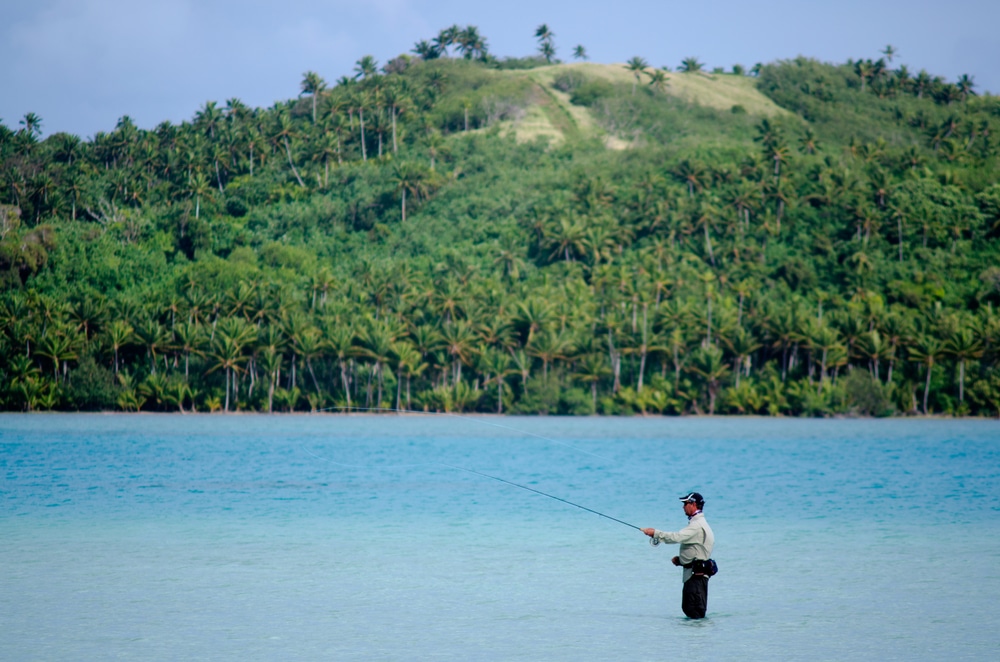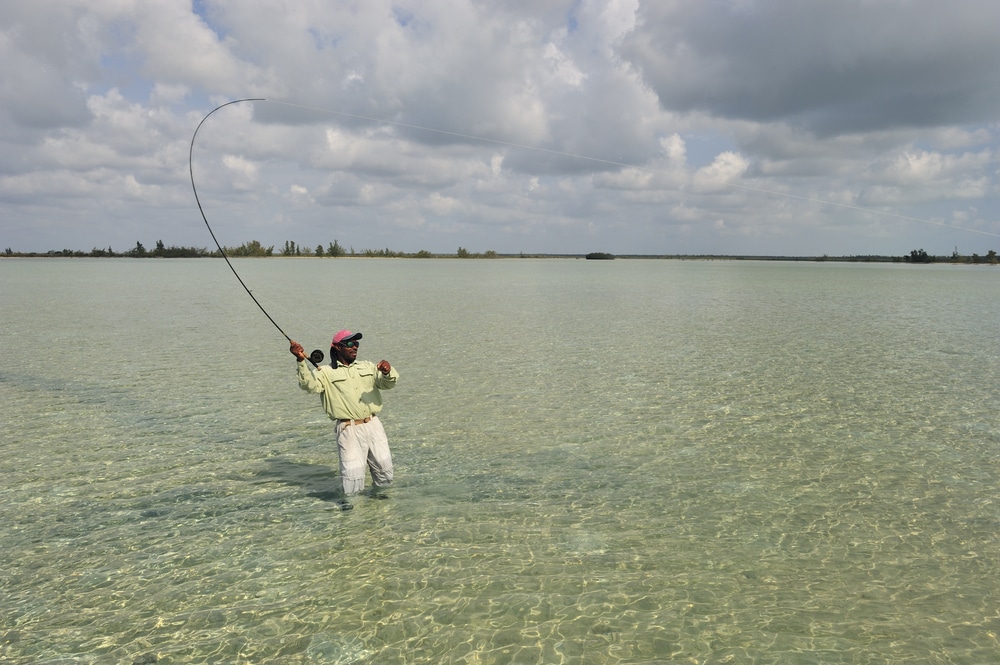The best times to go saltwater fly-fishing varies based on many factors. Those include:
- Seasonal Changes – This will vary depending on the species of fish. Some fish migrate and may not be present when you target them. It is important to do a little research on the types of fish that you want to target and then adjust your fishing schedule to meet their habits.
- Time of the day – As a general rule, dawn and dusk are the two times of day when saltwater fish are most active. It is not always practical to toss flies at dusk, but you can toss them in the late afternoon and into the evening and have good fishing success. For those of you who do not fancy getting up in the dark to be on the ocean as the night begins to fade, you can fish in the early morning with good success.
- Moon Phase – Silly as it seems, the moon plays a huge role in the life of fish. A full moon is a good time to fish after dark. There is much more light on a full moon and that means fish that do not see well in the dark will feed longer. The moon also affects the tidal flow of the water and a full moon can produce higher tides while a new moon may produce lower tides. High tides cause bait fish to swim more actively because the small creatures that bait fish feed on are also disturbed due to the rougher water action.
- Weather Patterns – Weather plays a large role in how fish behave. Warmer days and temperatures tend to make fish go deeper. Most species of fish have a “sweet” spot in terms of water temperature. You can find that out by doing a little research. if you are using a fish finder, use one that tells you water temperatures at specific depths. Fronts are a big clue to fishing. An incoming front that produces a drop in barometric pressure causes fish to hunt for food. They know a storm is coming, and they forage so that they can hunker down during the storm.
- Barometric pressure – Dropping pressure usually means fish are in a feeding frenzy of sorts. Rising pressure indicates storm weather and fish may seek shelter and stay there until the turbulence passes.
- Water Temperature – A vital detail that successful anglers pay attention to. Water temperature plays a huge role in fish behavior. It can signal spawning times, run times, migration times, and so many other factors. The ideal water temperature will change based on each species. Spotted sea bass have an ideal water temperature of 68-78° F, whereas, the ideal water temperature for red drum is 70-90° F. If you are just out fly-fishing in general, a good temperature range is 62-82° F. You will find many inshore species active and ready to bite flies.

Contents
What Is the Best Temperature for Saltwater Fishing?
How you answer that question depends on whether you are targeting a specific species of fish or just being a generalist (trying your luck for whatever is out there.)
Specific species of saltwater fish will have their own ideal “special” temperature for when it is best to target them.
For example, Sea Trout are active when the water is 69-80° F.
Black Bass have an ideal snapper is 58-62° F.
That’s a big range. If you are looking to just fish, then try fly-fishing when the water is between 62-82° F.
That temperature range is when a lot of saltwater fish are active.

Can You Fly Fish in Both Fresh and Saltwater?
Yes. Fly fishing is traditionally a freshwater sport.
However, in recent years it has progressed to the point that saltwater fly-fishing is quite popular.
If you are experienced in freshwater fly-fishing you can easily adapt to saltwater fly-fishing.
You will need to change your fly patterns, but the options there are almost unlimited.
A good place to start to fly fish in saltwater is near shore or estuaries.
The Gulf of Mexico and off the coast of Florida are two places that come to mind as destinations for saltwater fly-fishing.
But really, the options are worldwide.
Can I Use a Freshwater Fly Rod in Saltwater?
Maybe. Fly rods are different from regular fishing poles. A fly rod is designed for a specific weight of the fly.
Fly rods do not require a weight or sinker, so the fly has to be of the right weight or size to handle the line.
If the fly you plan on using is the same as you would in fresh water, then the rod should be okay for saltwater fishing.
The big difference between the two is that a saltwater reel will protect against the corrosive nature of salt.
A freshwater reel may not have the specific ability, so you will need to clean the reel each time you use it to make certain there is no salt residue on the reel.
That means removing the line from the reel each time you use the freshwater reel in saltwater.
If you are thinking about setting up a rod for freshwater and saltwater, aim for a freshwater rod that will handle Salmon.
Many of the saltwater fishing targets will be larger than most trout and largemouth bass.
In fact, you can fly fish for tarpon, – and they are giant.
For those specialized species of saltwater fish, you would want to set up a rod and reel combo that is specific to that species.
A good 9″ or 10′ fly rod in the 9-weight range is a good bet for fish around 20-40 pounds.
A big redfish can easily weigh 30 pounds. Pair this with any of the fly reels that are rated for tropical water and braided line.
Leader material can be fluorocarbon and are generally long – 9-12 feet tapered from butt to tip in the 40-20 pound range.
That line will handle the bigger and fluffier flies needed for fish like Red Drum.
Can I Use a Saltwater Fly Reel in Freshwater?
Yes. The difference between a saltwater reel and a freshwater reel is that the saltwater reel is sealed to protect the reel from the salt.
There is no harm in using a saltwater fly reel in freshwater.
You still want to aim to keep your reel dry.
A freshwater fly reel is also sealed to help keep the working parts dry and working properly.
There is extra sealing to protect from the corrosive nature of salt with most saltwater gear.
Note: Fly-fishing gear is generally hardy in all types of weather. It is not uncommon to fly fish in the rain.
Expect that your reel will get wet. If you choose a quality reel the manufacturer will have produced a product that will handle the water – saltwater or freshwater.
What Is the Best Fly Rod for Saltwater Fishing?
G. Loomis and Sage are two top brands. If you are getting into fly-fishing for saltwater, then either brand is a good investment.
Fly rods tend to be life-long investments so buy the best quality rod you can afford.
There are other brands that are also good, such as Clearwater, and TFO.
Specs for Salt Water Fly Rods
In terms of size and weight – a nine weight is good in the 9-10 foot range.
There is an argument over longer rods and casting accuracy but for the most part, these do not apply to fly-fishing because you are going to be tossing larger and heavier flies than you would in freshwater.
Choose a rod that is designated for salt water as the reel and components of the rod will be able to handle the salt, which is corrosive.
A fast action is a good option, with medium – medium/heavy power.
Big fish will put a stout fly rod through the works, and you want a rod that will stand up to that action.
Match the Rod to Your Fishing Targets
Each rod will tell you the weight of the flies, and line pound test so pick a rod that fits the nature of the fish you will target.
Line Options for Saltwater Fly-fishing
For line choice, a braided line is a standard for fly fishing.
It is thinner in diameter than comparable pound test mono or fluorocarbon lines, which means you can often get more of the braided line on your reel.
For leaders, a floating line with a tippet or tapered leader is key.
Forty-pound test butt strength for a tapered leader is good along with a tip that is rated in the 20-pound test range.







